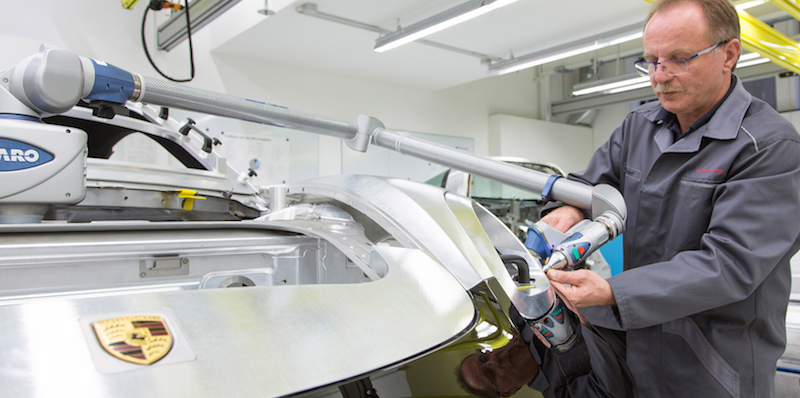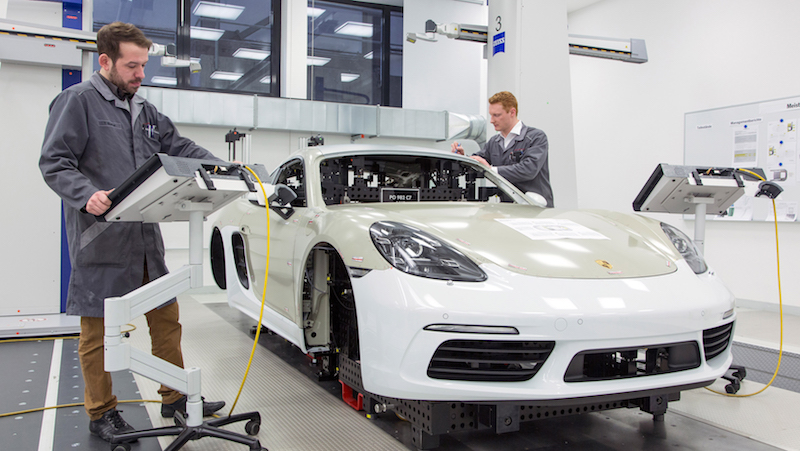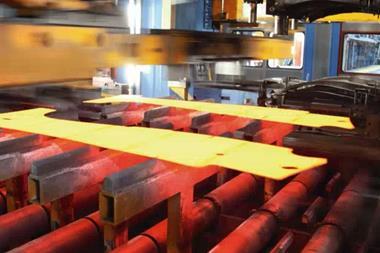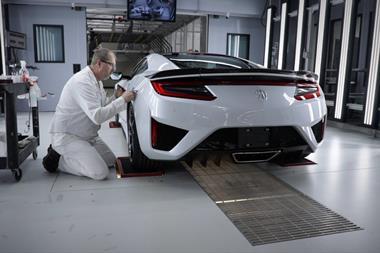Data-led analysis and audit are helping Porsche to maintain and enhance its production quality values
 According to Porsche more than two-thirds of all the cars it’s ever built are still driving today. The sportscar maker cites quality as “a typical trait” and it’s clear that the analysis centres and final audit areas at both Leipzig and the original plant at Zuffenhausen are key components of Porsche’s overall quality process.
According to Porsche more than two-thirds of all the cars it’s ever built are still driving today. The sportscar maker cites quality as “a typical trait” and it’s clear that the analysis centres and final audit areas at both Leipzig and the original plant at Zuffenhausen are key components of Porsche’s overall quality process.
The centres are important launch points, especially in production start-up of new vehicles as well as for detailed failure cause analysis for different parts.
The OEM’s goal is to have series production operating with optimum results right from the outset. “At Porsche, quality is the result of intensive work that is driven by a love for the perfect sports car in all of its phases and aspects. When it comes to quality topics, we study every little detail to its roots – that is what distinguishes Porsche,” says Albrecht Reimold, executive board member for production and logistics at Porsche.
Two methods that illustrate the meticulous quality work are cubing and the exterior masterjig (or Meisterbock).
Cubing, milling a full size car body from solid aluminium, serves as a highly accurate benchmark for optimising and qualifying assembly parts and in functional analysis of add-on parts. Deviations can be found even down to tenths of a millimetre. It can be used across such wide ranging purposes as checking a leather-upholstered cockpit fitted in the in-house leather shop or to achieve precise fit and visual quality for headlights.
The exterior Meisterbock is used in tandem with precise measuring instruments for functional analysis of sheet metal and add-on parts, examining height contours and seams to an accuracy in tenths of millimetres.
Porsche interprets customer expectations with regard to quality as being multi-dimensional and as such strives to embody quality competence throughout the entire operation. “Each unit has a high level of self-motivation to achieve the best possible quality,” says Frank Moser, vice president for corporate quality. “We do not need to persuade anyone to care more about perfection or quality in their technical area.”
Body tracking When Porsche was planning its new bodyshop for Leipzig, data was as much a consideration as bricks and mortar. The key was to create a highly flexible bodyshop which could deliver a consistent product and, as Timo Voss leads production control technology at the plant explains, “a design that kept people at the centre of process control.”
The MSB bodyshop at Leipzig, opened in 2016 for the latest generation of Panamera, has a production area equivalent to eight soccer pitches.
Around 475 robots and 189 employees are needed for the construction, with a vertical integration of over 90 per cent. The Panamera body is made up of 430 individual parts and created by thermal and mechanical joining methods, and more than 200m of adhesive. On average, 13 bodies are produced per hour in the MSB body shop.
 The assembly modules (ZSBs) are transported using electric monorail systems to the installation location of the corresponding assembly line. A factory control system (body tracking) oversees that each ZSB is in the right place at the right time. This allows comprehensive identification, control and visualisation of all production parameters in the bodyshop.
The assembly modules (ZSBs) are transported using electric monorail systems to the installation location of the corresponding assembly line. A factory control system (body tracking) oversees that each ZSB is in the right place at the right time. This allows comprehensive identification, control and visualisation of all production parameters in the bodyshop.
For its digitisation to succeed, Porsche established four pillars to support production: data consistency, control, regulation and optimisation.
Voss says: “Those are the most important aspects which we are trying to manage in a digitised way. In our MES, we have central plant visualisation and monitoring, we have quality systems to keep in mind and the equipment systems which control the robot technology.”
Besides the robots of shopfloor level, Porsche has its ‘data world’ which does the job of tracking the different models. This body-tracking cloud communicates with several media interfaces as well as a centralised quality system and several databases. From the initial component, the system assigns the ZSB to a vehicle order and verifies availability of each of the necessary components for the job. All fabricated assemblies and bodies are marked by a QR code and RFID, then tested several times during the production run.
Voss says: “This label has to carry the digital job order through the entire process. So it needs to be durable, staying intact through the paintshop and to final assembly.”
Robust and reliable Hoisting conveyors are scanned to verify from the cloud that the arriving parts are correct. If all is in order the job order is sent to the appropriate plant division. The parts are then lowered and fitted. Take, for instance, the front end being fitted to the floorpan. The crucial issue is that the job is stored in the RFID label, removing any ambiguity around the vehicle. The job ID is then wedded to the ID of the skid it is placed upon for its passage through the bodyshop. This merger is then stored in the cloud.
Afterwards, each station can read the skid ID and take instruction from the cloud about the parts to verify and install. The documentation deals not just with parts fitted but the joining techniques used.
The data transfer and retrieval around the bodyshop requires up to 70,000 messages per day, a volume which underlines the need for robust and reliable system. Voss reiterates: “There is a consistency of data and systems throughout the bodyshop, paintshop and assembly. This makes it possible for us to have a high number of variants without long tooling set-up times.”
Quality methods and tasks Cubing: pilot series qualification of add-on parts for exterior and interior.Exterior Meisterbock: pilot series qualification of body parts with regard to fit, seams and transitions as well as matching of body and assembly parts.Seam Meisterbock: pilot series qualification of structurally relevant body parts for fit and joinability.Total vehicle analysis: mobile and stationary measuring instruments.Body-in-black: pilot series qualification of sheet metal parts.Total vehicle audit: all vehicle parts installed at the Zuffenhausen and Leipzig production sites are qualified and analysed using the instruments and methods mentioned above.
Porsche quality and analysis centres
Zuffenhausen: Analysis shop with six stations includes electrical/electronic analysis, a measuring instrument area with six analysis stations, three of which have stationary measuring machines with very high precision (hundredth of a millimetre range) and mobile measuring equipment for analysis around the total vehicle and in cubingOpened: July 2014 | Floor area: 3,000 sq mPIC: Zuffen analysis
Leipzig: A master jig and cubing centre feature among nine stationary coordinate measuring machines and five mobile measuring systems for the tasks of exterior master jig, seam master jig and cubing, Master jig and cubing centre laid out for up to four production start-ups in parallel, Pilot centre for building pilot series vehiclesOpened June 2016 | Floor area: 6,000 sq mPIC: Leipzig analysis





































